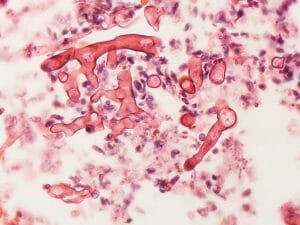Hyphae Basics
Hyphae are masses of tubular thread-like filaments filled with cytoplasm and have a cell wall. Some hyphae are one long tube while others are divided into compartments by walls called septa. The septa are perforated to allow cytoplasm and molecules to move between cells, but small enough so that organelles cannot.
Structure and Growth of Hyphae
Hyphae are a structural component of fungi used for penetrating the soil and other surfaces, secreting enzymes, breaking down organic material, and absorbing nutrients. Another part of fungi, the mycelium, is made from networks of hyphae that cluster together and comprise the vegetative portion of the organism, like what is seen with mushrooms, truffles, etc. The mycelium develops spores which give rise to new hyphae. Hyphae grow longer at the tips using an organelle called the spitzenkörper (a German word which means pointed body).
Coenocytic Hyphae
Coenocytic hyphae are nonseptate, also called aseptate, meaning they are one long cell that is not divided into compartments. The word coenocytic (coenocyte) comes from the Greek words koinós meaning ‘common’ and kýtos which means ‘box’ (cell). Coenocytic hyphae result from nuclear divisions within a cell without an accompanying division of the cytoplasm (cytokinesis). Coenocytic hyphae have several nuclei scattered around in the cytoplasm along with ribosomes, Golgi apparatus, and endoplasmic reticulum.
The lack of septa is generally seen in more primitive fungi such as those in the class Zygomycetes (now called Mucormycetes) which are the distant relatives of fungi with septate hyphae like Basidiomycetes and Ascomycetes. Coenocytic hyphae have septa, but they are only at the branching points. This prevents the entire tubular mass from being compromised if one hypha is damaged.
A 2013 study examined the DNA of a fungus with coenocytic hyphae, Rhizopus irregularis, to help understand how it and others in its phylum Glomeromycota, evolved to have a symbiotic relationship with the roots of crop plants and why it was an essential phylum for the evolution of terrestrial plants. The researchers found that Rhizopus irregularis has a low level of gene polymorphism, meaning there is a lack of genetic variation one would expect to see in a species that gives rise to highly diverged genomes. A hypothesis to explain this comes from their finding of extra genes related to mating. This could mean there were important, yet not understood reproductive differences in the evolutionary past of the organism. In addition, the study found no genes that encode for enzymes that degrade cell walls, or that are involved in toxin and thymine synthesis. Also, the researchers detected an abundance of DNA coding for secreted proteins in the symbiotic tissues that interact with the roots of crops.

The image above shows coenocytic hyphae in a fungus of the class Mucormycetes.
References
- Ahmadjian, V., Alexcopoulos, C.J. & Moore, D. (2018). Fungus. In Encyclopedia Britannica online. Retrieved from https://www.britannica.com/science/fungus
- Coenocyte. (n.d.). In Wikipedia. Retrieved April 18, 2018 from https://en.wikipedia.org/wiki/Coenocyte
- Tisserant, E., Malbriel, M., Kuo, A., Kohler, A., Symeonidi, A., Balestrini, R.,…Martin, F. (2013). Genome of an arbuscular mycorrhizal fungus provides insight into the oldest plant symbiosis. Proceedings of the National Academy of Sciences. 110, 20117-20122. DOI: 10.1073/pnas.1313452110
Coenocytic Hyphae
No comments:
Post a Comment